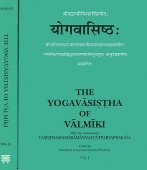Upasita, Upāsita: 10 definitions
Introduction:
Upasita means something in Hinduism, Sanskrit, Buddhism, Pali, Marathi, Hindi. If you want to know the exact meaning, history, etymology or English translation of this term then check out the descriptions on this page. Add your comment or reference to a book if you want to contribute to this summary article.
In Hinduism
Yoga (school of philosophy)
Source: ORA: Amanaska (king of all yogas): A Critical Edition and Annotated Translation by Jason BirchUpāsita (उपासित) refers to “worshipping (the Guru)”, according to the Amanaska Yoga treatise dealing with meditation, absorption, yogic powers and liberation.—Accordingly, as Īśvara says to Vāmadeva: “[...] Just as copper becomes gold from the touch of fixed mercury, [so] the student becomes absorbed in the highest reality from hearing the teachings of the Guru. If [the Yogin] worships (upāsita) the guru fully he will obtain from him the natural [no-mind state] without effort. [So,] he should devote himself at all times to this practice of the self. [...]”.

Yoga is originally considered a branch of Hindu philosophy (astika), but both ancient and modern Yoga combine the physical, mental and spiritual. Yoga teaches various physical techniques also known as āsanas (postures), used for various purposes (eg., meditation, contemplation, relaxation).
Languages of India and abroad
Pali-English dictionary
Source: BuddhaSasana: Concise Pali-English Dictionaryupāsita : (pp. of upāsati) attended or serve.
Source: Sutta: The Pali Text Society's Pali-English DictionaryUpāsita, (pp. of upāsati) honoured, served, attended S 1133, cp. Nd2 165; Th. 1, 179. (Page 150)

Pali is the language of the Tipiṭaka, which is the sacred canon of Theravāda Buddhism and contains much of the Buddha’s speech. Closeley related to Sanskrit, both languages are used interchangeably between religions.
Marathi-English dictionary
Source: DDSA: The Molesworth Marathi and English Dictionaryupāsita (उपासित).—p (S) Worshiped, served, adored, reverenced.
Marathi is an Indo-European language having over 70 million native speakers people in (predominantly) Maharashtra India. Marathi, like many other Indo-Aryan languages, evolved from early forms of Prakrit, which itself is a subset of Sanskrit, one of the most ancient languages of the world.
Sanskrit dictionary
Source: Cologne Digital Sanskrit Dictionaries: Shabda-Sagara Sanskrit-English DictionaryUpāsita (उपासित).—mfn.
(-taḥ-tā-taṃ) 1. Served, honoured, worhipped. 2. Serving, paying worship or service. E. upa inferiority, ās to sit or remain, affix kta.
Source: Cologne Digital Sanskrit Dictionaries: Monier-Williams Sanskrit-English Dictionary1) Upāsita (उपासित):—[from upās] mfn. served, honoured, worshipped etc.
2) [v.s. ...] one who serves or pays worship.
Source: Cologne Digital Sanskrit Dictionaries: Yates Sanskrit-English DictionaryUpāsita (उपासित):—[upā+sita] (taḥ-tā-taṃ) a. Served.
Source: DDSA: Paia-sadda-mahannavo; a comprehensive Prakrit Hindi dictionary (S)Upāsita (उपासित) in the Sanskrit language is related to the Prakrit word: Uvāsiya.
Sanskrit, also spelled संस्कृतम् (saṃskṛtam), is an ancient language of India commonly seen as the grandmother of the Indo-European language family (even English!). Closely allied with Prakrit and Pali, Sanskrit is more exhaustive in both grammar and terms and has the most extensive collection of literature in the world, greatly surpassing its sister-languages Greek and Latin.
Hindi dictionary
Source: DDSA: A practical Hindi-English dictionaryUpāsita (उपासित):—(a) a dored, worshipped.
...
Kannada-English dictionary
Source: Alar: Kannada-English corpusUpāsita (ಉಪಾಸಿತ):—[adjective] worshipped; adored.
Kannada is a Dravidian language (as opposed to the Indo-European language family) mainly spoken in the southwestern region of India.
See also (Relevant definitions)
Starts with: Upasitapasi, Upasitar, Upasitavya.
Ends with: Anupasita, Paryupasita, Payirupasita.
Full-text: Paryupasitapurvatva, Anupasita, Uvasiya, Paryupasita, Upasati.
Relevant text
Search found 5 books and stories containing Upasita, Upāsita; (plurals include: Upasitas, Upāsitas). You can also click to the full overview containing English textual excerpts. Below are direct links for the most relevant articles:
Brihad Bhagavatamrita (commentary) (by Śrī Śrīmad Bhaktivedānta Nārāyana Gosvāmī Mahārāja)
Verse 2.3.178 < [Chapter 3 - Bhajana (loving service)]
Chandogya Upanishad (Madhva commentary) (by Srisa Chandra Vasu)
Mysticism: Its Nature and Function < [July 1965]
Consciousness in Gaudapada’s Mandukya-karika (by V. Sujata Raju)
Various views of nature of reality < [Chapter 4: Study of Māṇḍūkya Kārikā: Vaitathya Prakaraṇa]
A History of Indian Philosophy Volume 5 (by Surendranath Dasgupta)
Part 2 - Śaiva Philosophy in the Vāyavīya-saṃhitā of the Śiva-mahāpurāṇa < [Chapter XXXVII - The Śaiva Philosophy in the Purāṇas]
Related products
